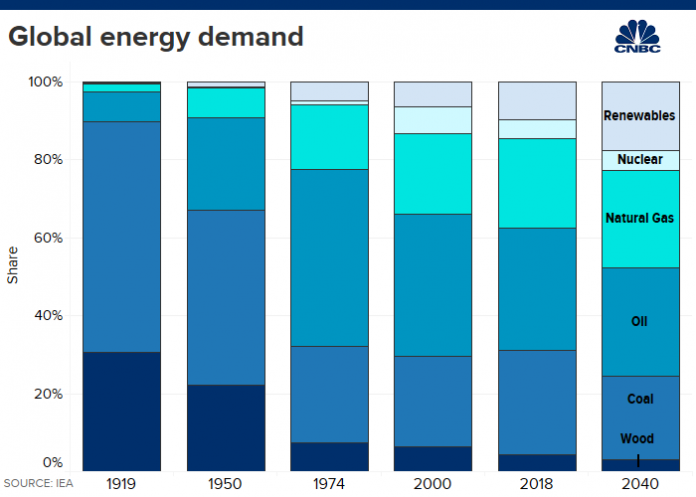The world may be shifting toward renewable energy, but the pace isn’t fast enough to offset the impacts of worldwide economic expansion and a growing population, the International Energy Agency (IEA) warned.
In its World Energy Outlook 2019 report, released on Tuesday, the Paris-based policy adviser said that while the importance of transitioning to a carbon-neutral world is recognized, society is still heavily dependent on fossil fuels and it will remain that way unless major policy changes are made.
Despite growth in alternative energy sources like wind and solar power, carbon emissions still hit an all-time high in 2018.
If drastic changes are to be made, governments will need to “take a hard, evidence-based look at where they stand and the implications of the choices they make,” the report said.
While the outlook may seem dire, the IEA said that tectonic shifts in energy demand and consumption are possible. The agency pointed to the United States’ path to becoming a net exporter of oil and gas — once thought impossible – as evidence that wide-scale change is feasible.
“The shale revolution highlights that rapid change in the energy system is possible when an initial push to develop new technologies is complemented by strong market incentives and large-scale investment,”
IEA executive director Fatih Birol said.
For a similar scenario to play out when it comes to carbon emissions, significant changes must be made quickly and “governments must take the lead,” the report concluded.
Renewables growing, but not fast enough
Under its stated policies scenario, the IEA forecasts that growth in renewables will continue — led by hydro, wind and solar power — but the pace won’t be fast enough to offset the effects of expanding global economies and a growing worldwide population. Energy demand will rise by 1% annually through 2040, and while emission levels will slow, they won’t peak until after 2040.
IEA said that 50% of the added energy demand will be provided by renewables, with 35% met by gas. Under current projections solar will become the largest source of power by 2040, driven by declining costs. Wind will also be a key player, with power from offshore turbines expected to grow fifteen-fold by 2040.
This transition to renewable-focused energy will require supportive government policies.
“Policy makers and regulators will have to move fast to keep up with the pace of technological change and the rising need for flexible operation of power systems,”
The solar surge will come at the expense of coal, which is currently the largest power-related source of carbon emissions. IEA said that market share for the commodity would fall from 38% today to 25% in 2040.
Oil demand is starting to flatten out
A growing demand for renewable sources of energy, coupled with rising fuel efficiency and a transition to electric vehicles, will hit the oil sector. Under the stated policies scenario the IEA said that demand for oil would slow over the next decade, before flattening by the 2030s.
For the following years, it seems that, production will continue to rise, and the US will account for 85% of the increase in production over the next decade. In the next five years, the US’ shale output will exceed Russia’s total production.
“Aggregate fossil fuel production falls precipitously by 2040 … Natural gas output rises by around 8% to 2030 before falling below today’s levels in 2040. Oil production peaks in the next few years and drops to 65 million barrels per day (a level not seen since 1990) as the shift to alternative modes in the transport sector takes away its main demand base,” the report said.
New technologies
Significant investments will be instrumental in developing things like battery storage and carbon capture systems, as well as improving overall energy efficiency in order to reduce global emission levels.
Under the sustainable development scenario, spending on energy efficiency will reach $16.7 trillion by 2040, which is around $625 billion per year for the next ten years, and nearly $920 billion per year from 2030 – 2040. Similarly, investments in renewables would need to reach $650 billion per year for the next ten years in order to meet energy goals.
As things stand right now, under the stated policies scenario, energy efficiency spending is expected to total $11.7 trillion by 2040, with renewable spending projected to reach $440 billion per year.
Given the dependence on coal in many emerging Asian economies, the report also discussed ways to reduce emissions from ongoing production, including retrofitting plants with carbon capture technology.
Ongoing hurdles
There’s a widening gap between what the research says needs to be done to curb carbon emissions, and what is actually happening.
For instance, demand for electric vehicles is growing but so, too, is demand for much larger and much less energy efficient SUVs. The number of SUVs on the road around the world increased from 35 million in 2010 to over 200 million last year, representing 60% of the increase in the global car fleet over the 8-year period, the IEA said.
As the world tries to cut back on carbon emissions, rising temperatures and erratic weather patterns haven’t made it easy. IEA estimated that nearly one-fifth of 2018′s energy demand growth stemmed from hotter summers and colder winters.
Source: cnbc.com










